Immersed in a centuries-old olive grove overlooking the Ionian Sea, the Scolacium Archeological Park tells many stories. Time doesn’t stop, it overlaps, and the visitor is able to step back thousands of years to trace the development of this unique site and its people all in an afternoon.
SCOLACIUM – WHAT’S IN A NAME?
The location is strategic, on the eastern coast of Calabria’s narrowest point, just south of Catanzaro and north of Soverato. Scolacium is at the center of the Gulf of Squillace. Thus, the name, although there is a seemingly endless list of variations and spellings associated with the ancient site: Scylletium, Scylacium, Scolatium, Scyllaceum, Scalacium, Scylaeium, Minervium and Colonia Minervia.
While the sea may look calm from the waterfront, the Gulf of Squillace is actually stormy and rather rough further offshore, and in ancient times was notorious for being very dangerous. The Greeks called it the Sacred Gulf of Athena Skylletikos after the goddess of storms and shipwrecks, and established the colony Skylletion from which the successive names have derived.
When the Romans took control, they called the colony Minervia Scolacium to coincide with their own name for the goddess of wisdom and warfare. Scolacium was the birthplace of the Roman statesman, antiquities scholar and writer Cassiodorus (c. 485 – c. 585), who founded Vivarium, which was an important monastery, library and Biblical studies center in the area. The city’s urban nucleus was eventually abandoned and its inhabitants would settle in neighboring hills and found Catanzaro.
HISTORY OF SCOLACIUM ARCHEOLOGICAL PARK
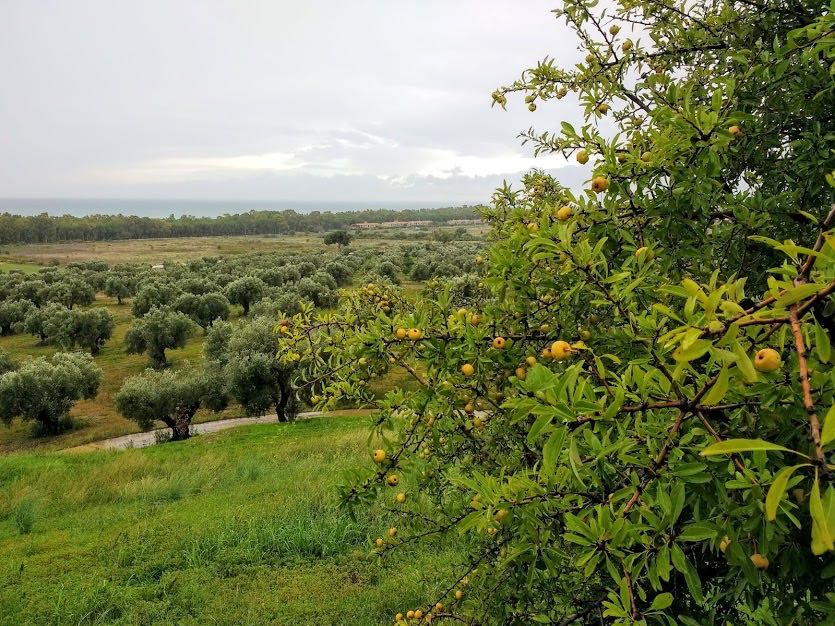
Looking out to the Ionian Sea from the Scolacium Archeological Park
The archeological park is located in the midst of rows and rows of olive trees with an average age of 200 years. One cannot help but notice the healthy vegetation and air of freshness the environment gives off. Interestingly, as historic as the site is, the Scolacium Archeological Park was only founded in 1982. The significance of the area had been known through discoveries of artifacts and historical references, but extensive archeological excavations at the heart of the site only began in the 1960s.
Residents of the area and passersby recognized the place more for the imposing remains of the Basilica Santa Maria della Roccella. This monumental ruin in the town of Borgia was located near the entrance of the olive plantation owned by the Mazza family, the baronial landowners. Today, the 35-hectare (87-acre) park encompasses Roman, Byzantine and Norman ruins, an antiquities museum and an historic olive mill. In addition to the precisely planted olive grove, the park is quite biodiverse and is home to a wide variety of fruit trees, some wild and some bygone species that were cultivated by the local farmers.
SANTA MARIA DELLA ROCCELLA
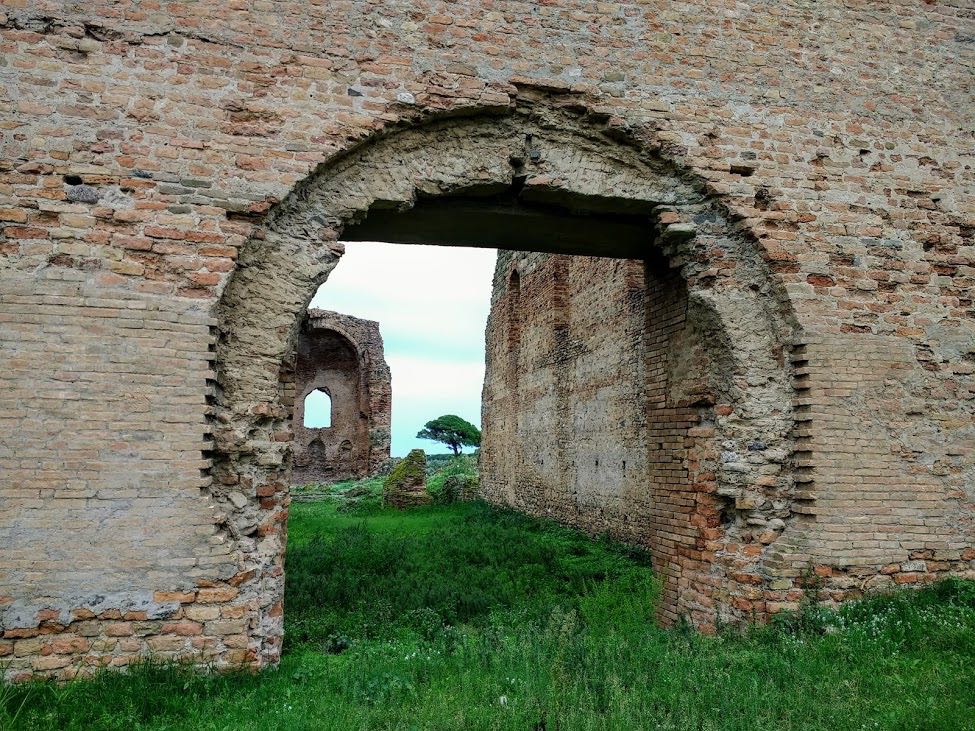
Santa Maria della Roccella Church
The tall, red-brick walls of the Santa Maria della Roccella Abbey make an impression sticking out of the olive trees, almost as if they were placed to create that quintessential pastoral effect. But what remains of the church is only a small part of what was once to be one of the largest abbeys in Calabria when the Normans began construction in the 11th century. The impressive Romanesque structure was strategically situated at the Gulf of Squillace to repopulate the area with a latinizing influence.
Although the large, single-nave basilica was never completed, the church served as a house of worship up until the devastating earthquake of 1783. In its life, Santa Maria della Roccella would be used for many purposes, including as a defensive structure and even as a pen for animals! You can’t get much more bucolic than that.
ANCIENT ROME IN CALABRIA
A visit to the Scolacium Archeological Park starts off with picturesque church ruins, the history above the surface. Further along the path, however, the story that for hundreds of years had been hidden below the surface can be seen. Of course, farm workers habitually came across bits and pieces of Roman statues, buildings and roads, but an official archeological excavation only began in 1965, when a sizable rectangular section of the olive grove was cut out to reveal the Roman forum.
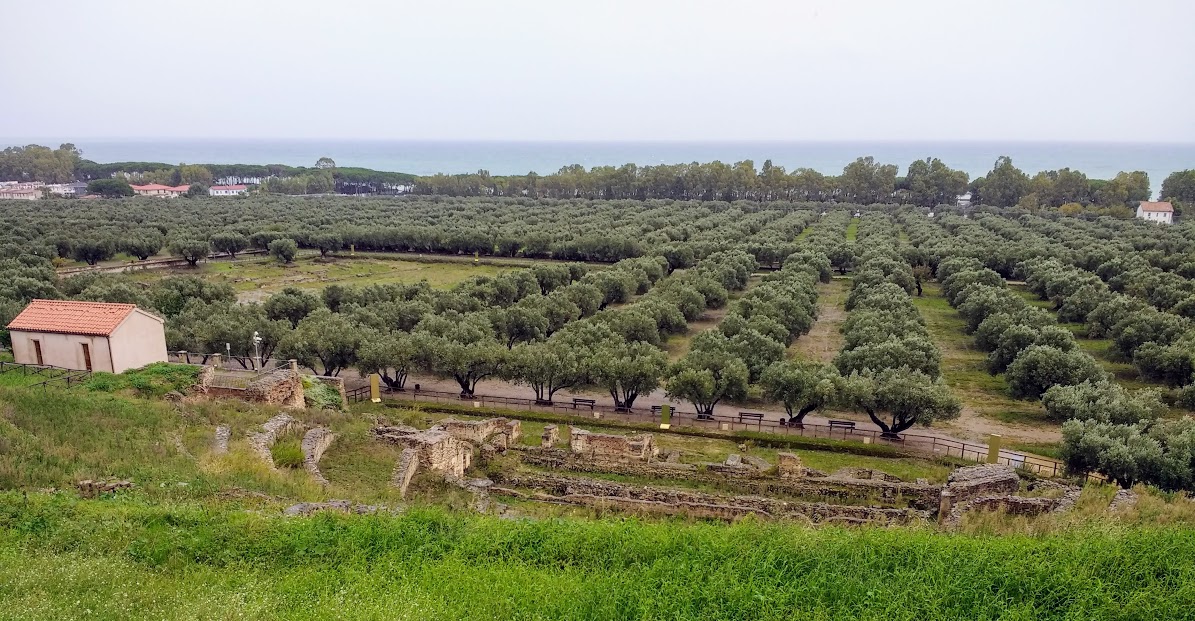
View of the Scolacium Archeological Park with the Roman theater in the foreground, Roman forum to the center-left and the Ionian Sea in the distance
Archeologists discovered the entire forum layout. Roads, foundations of public buildings and walls were traced through the settlement’s various phases starting from when the Roman colony was established at the end of the 2nd century BC to the beginning of the decline in the 4th century AD and abandonment a couple hundred years later. Many of the artifacts are on display in the park’s museum.
Other important structures in the park include a theater that could hold 3,500 people and a very large amphitheater that hosted gladiator shows and other bloody spectacles for an audience of between 9,500 and 12,000 onlookers. Excavations have also revealed an ancient necropolis, Roman houses and moving forward to the 6th-7th centuries, a Byzantine necropolis.
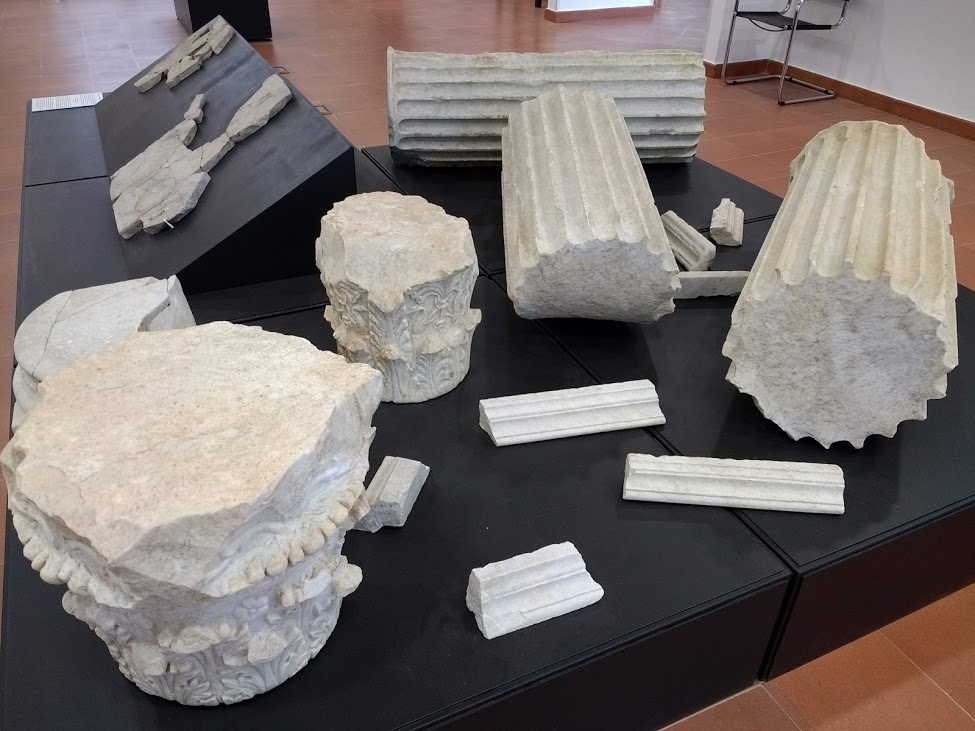
Roman architectural pieces from the Scolacium theater
SCOLACIUM ARCHEOLOGICAL MUSEUM
The residence of Baron Mazza, who lived just a stone’s throw from the forum, has been renovated to house the area’s beautiful artifacts. Material in the Scolacium Archeological Museum ranges from stone tools of the Paleolithic Period to ceramic pieces from the Greek and Bruttii civilizations, and to marble sculptures of the Roman Era, the institution’s focus.
For me, the statue that makes the biggest impression is one that is covered all over with scratches, made by hoes of all things. At first glance I admire the folds of the woman’s toga attractively wrapped around her body. Then upon closer inspection, I see that the front of the marble sculpture is scraped up in a random manner. She must have been lying on her back rather close to the surface as the back side doesn’t have a graze. Struggling for air while waiting for the next blow—now that’s a nightmare.
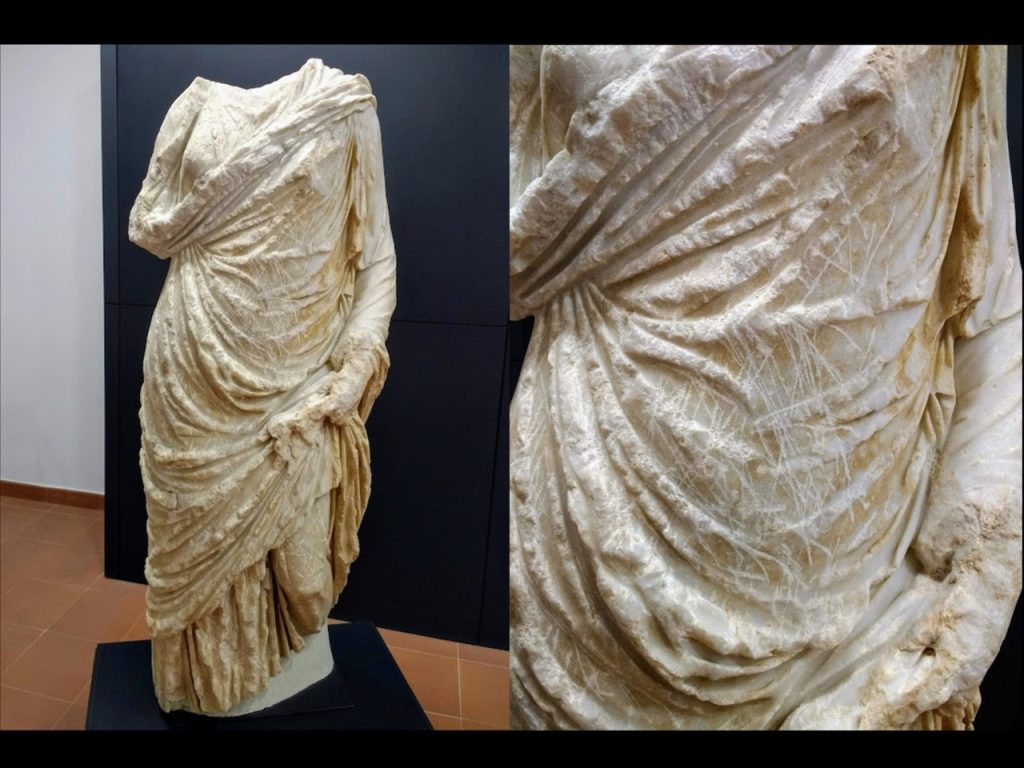
Scratched Roman statue
Another female statue is draped with the most delicate of garments that caress her form. She is the picture of elegance with her lovely gathered bodice and natural bearing.
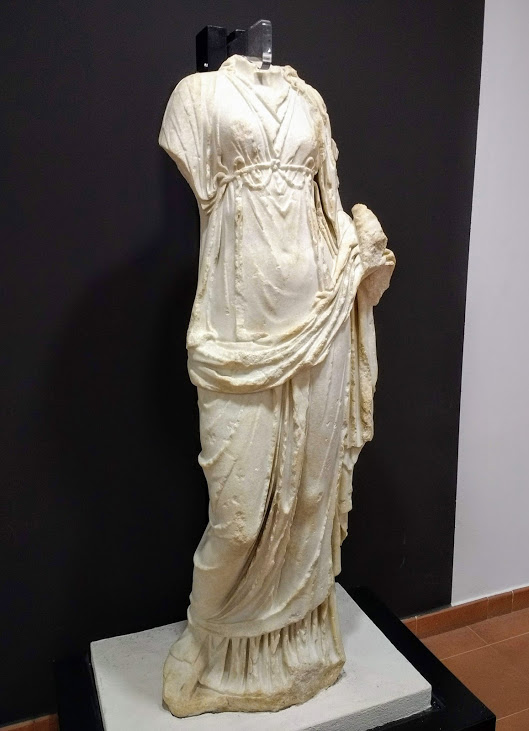
Ancient Roman Marble Statue
The museum’s 2nd-century, giant bronze arm was an early find, already in the collection of the olive farm’s 19th-century landowner. This right appendage would have belonged to a statue twice as tall as life-size judging from its 81-centimeter (32-inch) long forearm.
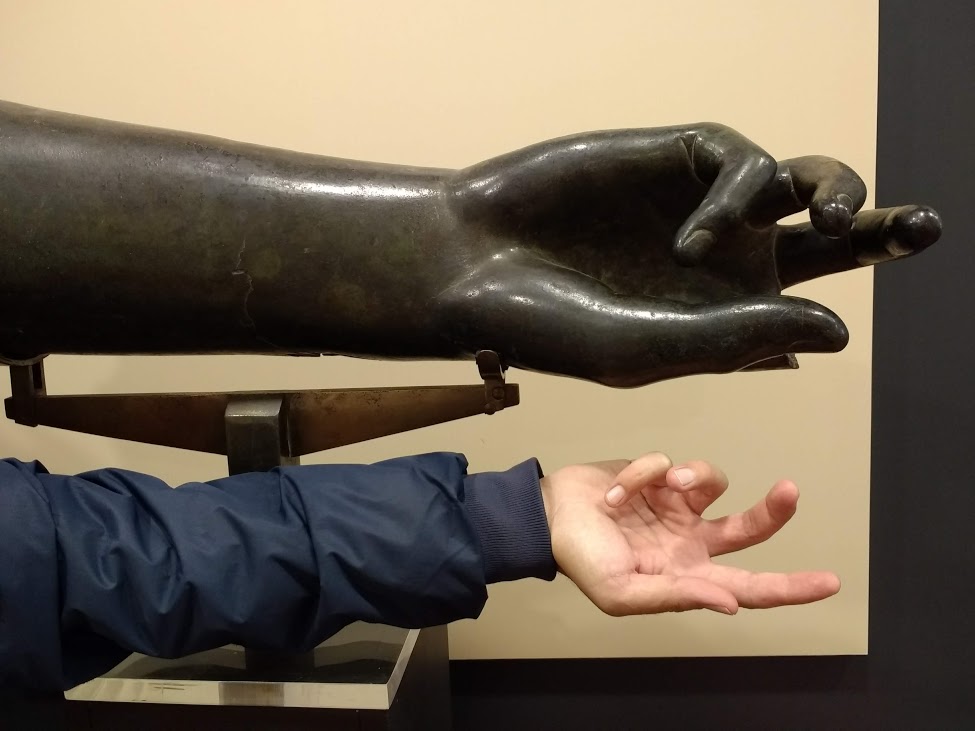
Right arm in bronze from the Roman Imperial Period
A bit jowly but with a kind expression, the 1st-century anziano obeso has an almost contemporary mien, although I ask myself if he would fit the parameters of an “elderly obese man” today. It’s no wonder that with the understated crinkles around his eyes and slightly furrowed brow, he was found in the area of the theater.
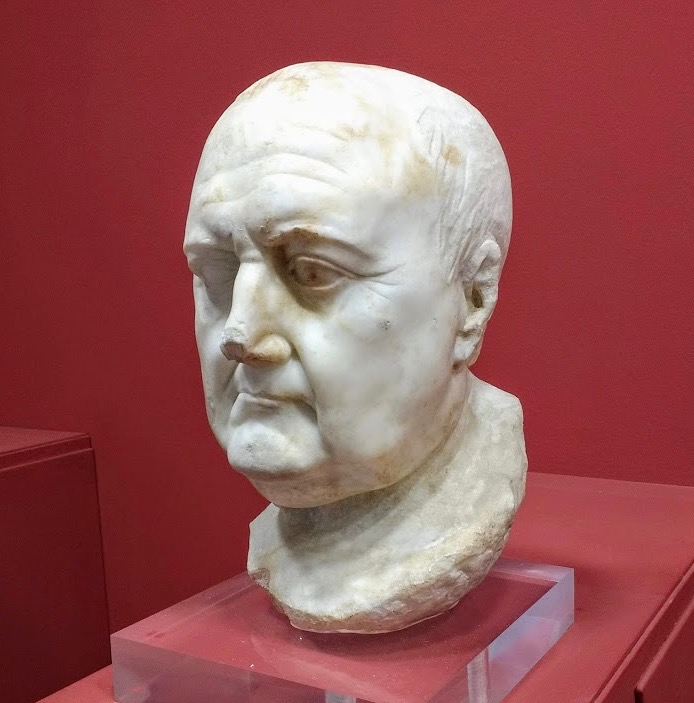
“Anziano obeso” – elderly obese man, Roman sculpture, Flavian Dynasty
OLIVE MILL MUSEUM
Time marches on, and the land was subjected to abandonment, seismic events, various governments and proprietorships. At the end of the 19th century, the terrain came into private hands. And on top of all this history and art, a working olive farm and mill flourished. At first the day-to-day workings were powered by man and oxen, but the Baron Mazza kept his operation up-to-date and the mill was mechanized and eventually electrified. This interesting olive mill and its innovative story is part of the Scolacium Archeological Park.
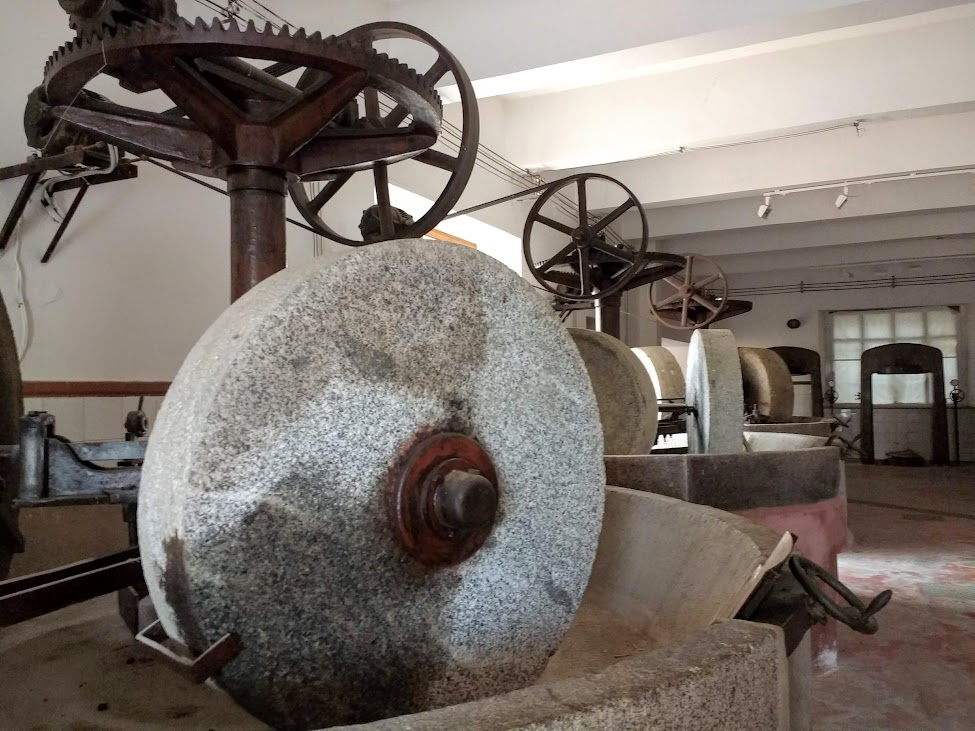
Olive Oil Factory Museum at the Scolacium Archeological Park
VISITING SCOLACIUM ARCHEOLOGICAL PARK
A visit to the Scolacium Archeological Park provides an excellent cross section of thousands of years of history, all played out in this strategic location at the “isthmus” of Calabria. As a matter of fact, Aristotle described the distance between the Gulf of Squillace on the Ionian Sea and the Gulf of Saint Eufemia on the Tyrrhenian as a “half-day’s walk.”
The park is situated just off state road 106 at the turnoff for Via Scylletion in Roccelletta di Borgia just four kilometers southwest of Catanzaro Lido. Call 0961-391356 to verify opening times. Or why not visit the Scolacium Archeological Park on my Calabria Tour?
Read more about the Province of Catanzaro in my blogposts Wooden Ecclesiastics of the Catanzaro Cathedral, Contemporary Art in the Catanzaro Park of Biodiversity, Morzello of Catanzaro, Badolato, The Corazzo Abbey, Lanificio Leo Textile Factory and Lamezia Terme and the Terme Caronte. And for an in-depth look at the beautiful land in the toe of the boot, check out Calabria: The Other Italy, my non-fiction book about daily life, history, culture, art, food and society in this fascinating southern Italian region. It’s available in paperback and e-book versions.
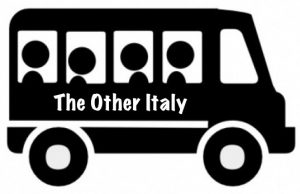 Would you like to travel to Calabria? Check out the itinerary for my in-depth Calabria Tour.
Would you like to travel to Calabria? Check out the itinerary for my in-depth Calabria Tour.
“Like” Calabria: The Other Italy’s Facebook page and follow me on Karen’s Instagram and Karen’s Twitter for more beautiful pictures and information.
Sign up below to receive the next blog post directly to your email for free.
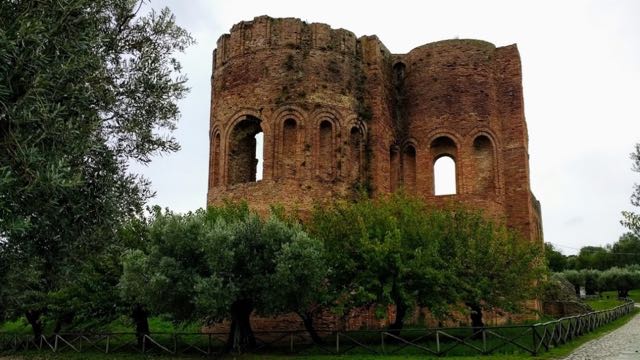
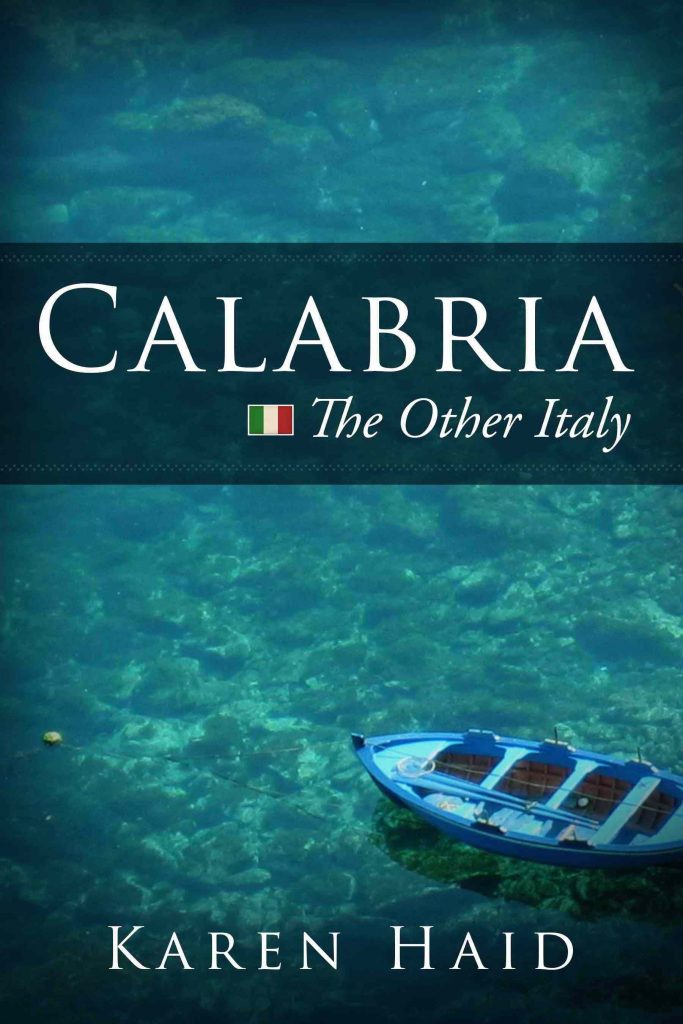
Comments 8
Interesting article! The head of Anziano Obeso reminds me of Winston Churchill!!! 😄
Author
Ha, ha! You’re right – I thought he looked familiar!
This is a great place to visit! I went last year and it was a great experience. The museum is quite well done and to think of how much actually lies beneath this area that still isn’t excavated is mind blowing.
Author
Yes, the area has an incredible potential.
Great post and photos Karen.
I’m yet to visit this park. Let me know when you’re next in Cosenza as would love to finally meet you – may be a cafe or Spritz?
Author
Thanks, you’ll love the park and museum with lots of great photo opportunities. D’accordo, ci vediamo a Cosenza!
Rosetta and Enrico took me to Scolacium the other day. It was a short drive from their place in Squillace Lido. I love archeological parks and olive groves, so i was happy. I hope they end up excavating more of the site. It is probably huge. Enrico showed me where there is a large wrapped up bronze frieze. It was too heavy to remove, so for now they just wrapped it up.
Well i enjoyed my unexpected, brief first visit to Calabria and definitely want to see more! Ciao, cristina
Author
Glad you enjoyed your first visit to Calabria! Scolacium is especially picturesque in the midst of an olive grove. And just think of the potential for the future, with archeological sites yet to be excavated, covered-up artifacts, even huge ancient mosaic floors they work on every once in a while and then bury again for next time around… Buone vacanze!